Castle of Sigri
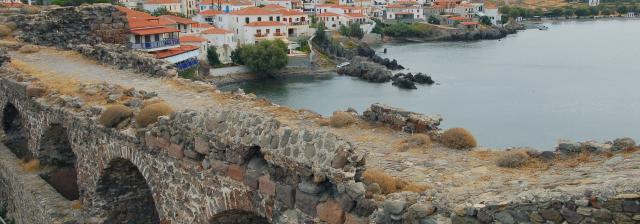
The castle is actually a Turkish fort which was built back in the Ottoman occupation of the island. It's main walls stand proud on the edge of the bay of Sigri and whilst inside there is little to see, it really is worth a visit. the battlements are in tact and you can climb up to the top of them to enjoy the most wonderful views of the village, beach and bay.Sigri Castle was built by the Turks in 1757 in order to protect the port of Sigri (back then the most important port for the transportation trade) from piracy. Throughout the Turkish occupation the castle constituted a central site of the country town, around which the settlement developed in the area protected by the castle.It is of small dimensions, square-like in its ground plan with square towers in its four corners. The central gate in the east closed with a double door covered with iron plates propped up by freckles. It is ornamented with a sharpened point arch -sample of typical Arabic architecture- constructed with alternate red and white stones. In the inner part of the fortress, the arched lintels (built by stones or bricks) of the cells that were used for the accommodation of the permanent guard are of similar inspiration. The castle is open all year and the etrance is free of charge.
The Mytilene Fortress
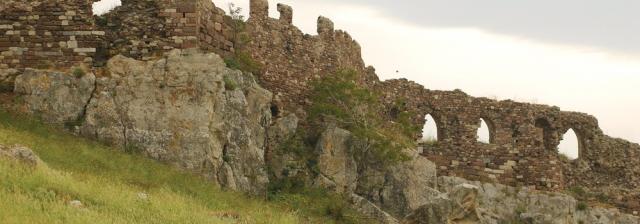
The invitation to a journey back in time inevitably means an exploration of the island’s past through the ruins of the castle and its fortifications. These eloquent monuments tell of the role the fortress has played in the life and protection of the city from the Byzantine era to the present day. The Mytilene fortress stands on a small hill, the highest point on the peninsula, between the city’s northern and southern ports. It was the largest and strongest of its kind in the Eastern Mediterranean. In ancient and Byzantine times, this peninsula was an island, separated from the rest of Lesvos by the Strait of Euripos. The Euripos was located approximately where Ermou Street is today and connected the northern and southern harbors. Silt and human intervention eventually eliminated the strait, transforming the islet into a peninsula.
The Roman Aqueduct at Moria
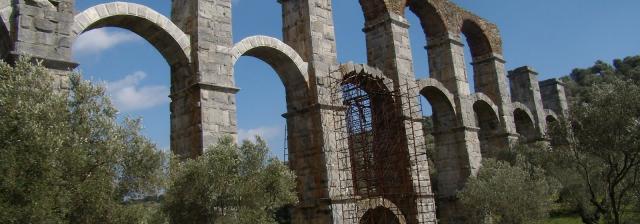
Near the village of Lampou Myloi are the remains of the Aqueduct, a work of superior technical mastery that was built in the 3rd century BC. The Aqueduct ran from Agiassos to Mytilene. Its arcade, stone blocks, piers, abaci and arches that comprised it were made from grey Lesbian marble. In its entirety it resembled the propylaia of a classical temple or palace. It began at the foot of Mt Olympos at Tsingos and traversed 26 kilometers, supplying water to Mytilene by a succession of underground ceramic culverts, channels carved in the cliff-face, and arches. The incline running the entire distance was designed in such a way that the water flowed in unhindered abundance. It was channeled from the Mytilene cistern to the city’s fountains, spas and estates.
Ancient place of Meson
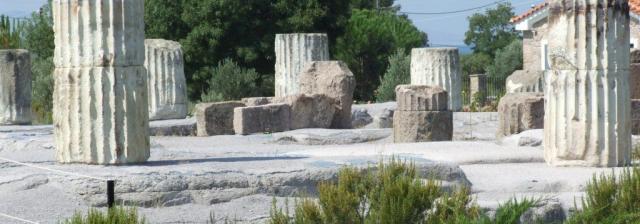
The ancient place of Meson, which was dedicated to Zeus, Dionysus and Hera, was a center of worship and communication and early 4th BC century was the seat of the public lesbian cities.Here were held in honor of Hera, pageant. At the site, visitors can see many architectural members of the church.
Tsarsi Hamam, Geni Tzami
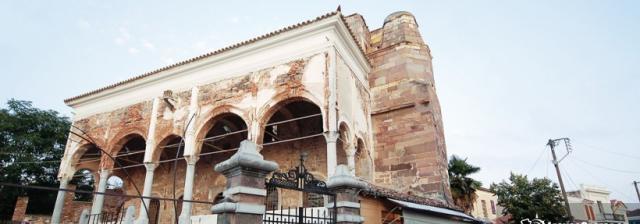
Tsarsi Hamam, Geni Tzami
Continuing north of the city of Mytilene, an alleyway on your left contains the 19th century Tsarsi Hamam. Both these elegant remnants of the Turkish occupation currently function as exhibition spaces.
Towards the end of Ermou Street at the turn off to the fortress is the beautiful mansion that once belonged to the Turkish governor Halim Bei and now houses the Municipal Library.
Vareltzidena Mansion
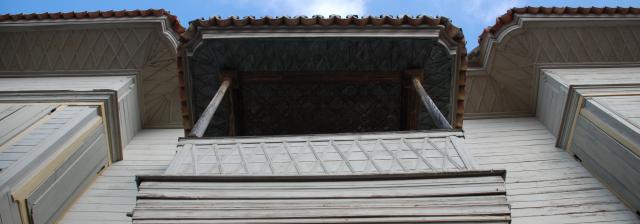
The Vareltzidena Mansion, built in the first half of the 18th century, is located in the centre of the village of Petra. It is a two-floor mansion, resembling a fortress because of the thick stone walls of the ground floor. The mansion combines elements of the local traditional architecture and influences from the Orient and northern Greece. In the past, the ground floor was used as a storeroom, in which olive oil and wine were kept. The first floor consists of a large reception hall, surrounded by six rooms.The walls of the reception hall are decorated with valuable frescoes, typical of the period in which the mansion was built. In one of the rooms the master of the mansion used to invite the elders of the village to discuss public matters.The throne of the master with the family blazon engraved on it still survives. The ceiling of the reception hall is decorated with wood-carvings representing a dove, the symbol of peace.
Sarlitza Pallas
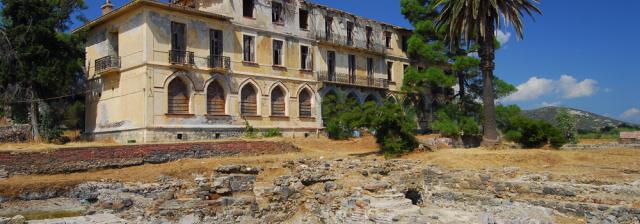
In the early 20th century Thermi was famous for its luxury hotel, the Sarlitza Pallas, which was built in 1909 based on the designs of French architects for Hassan Efendi Mola Mustafa.It passed into the hands of the Greek government and flourished for some 30 years, attracting visitors and famous figures from East and West alike. It began declining in 1933, with the exception of some small glimmers and, stuck in the gears of bureaucracy and indifference, finally succumbed to the ravages of time. Today only the baths are in operation.
Castle of Molyvos
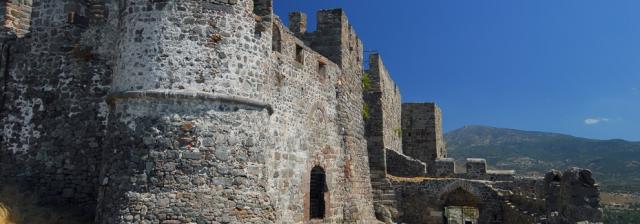
On top of a hill filled with pine trees, above Molyvos village, on the northern side of Lesvos, there is a strong Castle that dominates in the area. The Castle of Molyvos stands as a great historical monument for the whole island and as one of the best preserved castles in Eastern Meditarranean. Open to public, this castle and the castle of Mytilene are the most famous and strongest of Lesvos.The Castle of Molyvos (or Mythimna) was probably constructed in the mid 13th century and it was renovated in 1373 by the Genovese Frangisk I Guateluzo. However, it also went under reformations by the Turks in 1462, so it is evident that the architectural style went under many changes.
Skala Skamnia
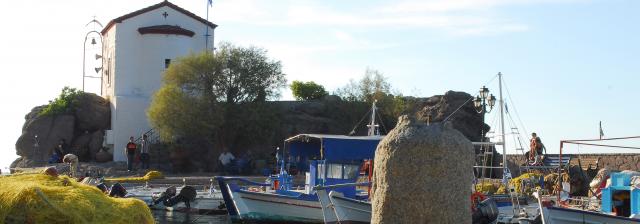
Skala Skamnia is renowned for the little church on the rock that provided the inspiration for the popular book, “Panagia i Gorgona” (“The Mermaid Madonna”), by the beloved Greek writer, Stratos Myrivilis. One of the island’s most developed tourist destinations, Skala Skamnia has plentiful lodgings, excellent seaside tavernas known for their fresh fish, and lovely little beaches, the best being the pebble beach of Kayia. From here you can drive along the coast on a good dirt road all the way to the once-powerful Mithymna, medieval Molyvos.
The Ancient Theatre of Mytilene
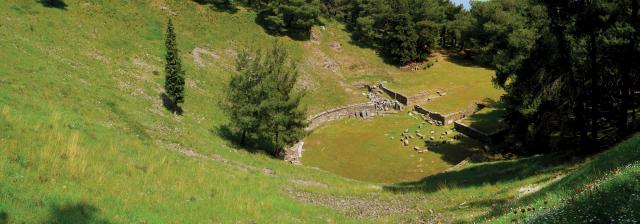
The celebrated Ancient Theatre is situated on the northern hill of the city in a pine-wooded area opposite the fortress, near the old refugee quarter. It was built in Hellenistic times and restored by the Romans. What we see today is the final building phase, which dates from late-Roman times. Excavations carried out in the 1950s unearthed the circular orchestra and the horseshoe-shaped concave seating area, which has been calculated to have held 10,000 spectators. The orchestra is a full circle, with a diameter of approximately 24.20 meters. It is separated from the entirely ruined seating area by a wall, which was tiled in marble, and the skene, which is divided into three corridors.

